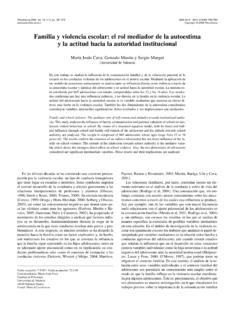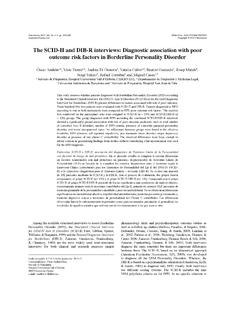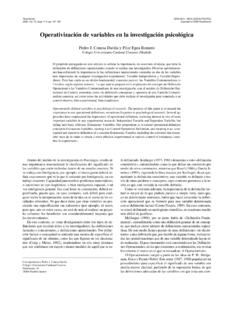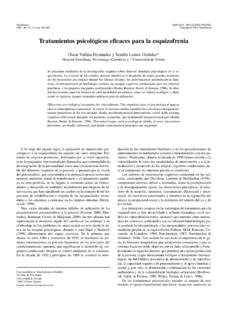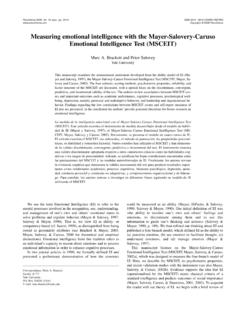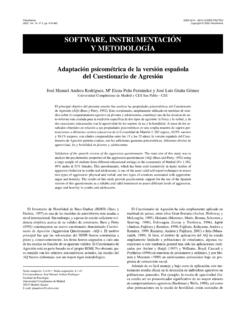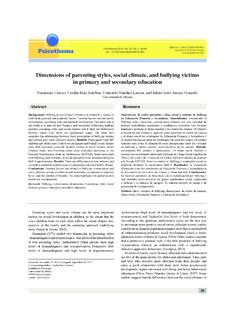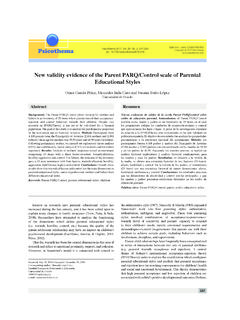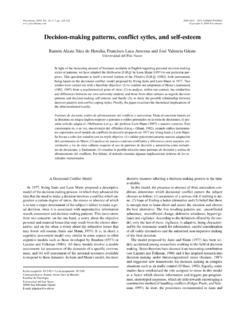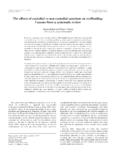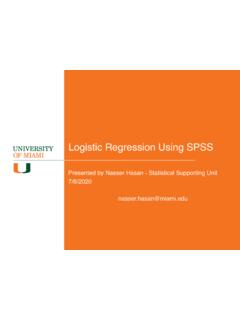Transcription of The 12-Item General Health Questionnaire (GHQ-12 ...
1 The General Health Questionnaire (GHQ) is a self-administered screening Questionnaire , designed for use inconsulting settings aimed at detecting individuals with adiagnosable psychiatric disorder (Goldberg & Hillier, 1979). In itsoriginal version, it had 60 items (GHQ-60), which were reduced to30 (GHQ-30), 28 (GHQ-28; in Spanish population see Gili, Ferrer,Roca, & Bernardo, 2000), and 12 items (GHQ-12) (Goldberg &Williams, 1988).The 12-Item General Health Questionnaire (GHQ-12) is themost extensively used screening instrument for common mentaldisorders, in addition to being a more General measure ofpsychiatric well-being. Its brevity makes it attractive for use inbusy clinical settings, as well in settings in which patients needhelp to complete the Questionnaire (Goldberg et al., 1997); itspsychometric properties have been studied in various countries(Werneke, Goldberg, Yalcin, & st n, 2000) and with varioustypes of population, for example, elderly people (Costa, Barreto,Uchoa, Firma, Lima-Costa, & Prince, 2006), and urologicalpatients (Quek, Low, Razack, & Loh, 2001).
2 Although it has sometimes been considered unidimensional(Corti, 1994), various works have clearly revealed the existence ofat least two factors in populations other than the Spanish one(Werneke, Goldberg, Yalcin, & st n, 2000). Factor analysis ofthe GHQ-12 has yielded 2- and 3-factor solutions, however, Gao,Luo, Thumboo, Fones, Li, and Cheung (2004) found that the 3-factor model proposed by Graetz (1991) that is, three factors,namely Anxiety and Depression, Social Dysfunction, and Loss ofConfidence fit the data better than others models. The customary type of scores used are a bimodel scale (0-0-1-1) and a 4-point Likert-type scale (0-1-2-3); the latter produces amore acceptable distribution of scores for parametric analysis(with less skew and kurtosis); Banks, Clegg, Jackson, Kemp,The 12-Item General Health Questionnaire (GHQ-12): Reliability,external validity and factor structure in the Spanish populationMar a del Pilar S nchez-L pez and Virginia DreschUniversidad Complutense de MadridThe purpose of this study was to analyze the internal consistency and the external and structure vali-dity of the 12-Item General Health Questionnaire (GHQ-12) in the Spanish General population.
3 A stra-tified sample of 1001 subjects, ages between 25 and 65 years, taken from the General Spanish popula-tion was employed. The GHQ-12 and the Inventory of Situations and Responses of Anxiety-ISRA were administered. A Cronbach s alpha of .76 (Standardized Alpha: .78) and a 3-factor structure (withoblique rotation and maximum likelihood procedure) were obtained. External validity of Factor I (Suc-cessful Coping) with the ISRA is very robust (.82; Factor II, .70; Factor III, .75). The GHQ-12 showsadequate reliability and validity in the Spanish population. Therefore, the GHQ-12 can be used withefficacy to assess people s overall psychological well-being and to detect non-psychotic psychiatricproblems. Additionally, our results confirm that the GHQ-12 can best be thought of as a multidimen-sional scale that assesses several distinct aspects of distress, rather than just a unitary screening Cuestionario de Salud General de 12 tems (GHQ-12): fiabilidad, validez externa y estructura fac-torial en poblaci n espa ola.
4 El objetivo de este estudio fue analizar la consistencia interna y la vali-dez externa y estructural del Cuestionario de Salud General de 12 tems (GHQ-12) en la poblaci n ge-neral espa ola. La muestra est compuesta por sujetos, de 25 a 65 a os de edad, de la poblaci nespa ola. El GHQ-12 y el Inventario de Situaciones y Respuestas de Ansiedad fueron encontr un alfa de Cronbach de .76 (alpha estandarizado: ) y una estructura de 3 factores (conrotaci n oblicua y el procedimiento de m xima verosimilitud). La validez externa del Factor I (Afron-tamiento exitoso) con el ISRA fue muy alta ( ; Factor II, .70; Factor III, .75). El GHQ-12 demos-tr una fiabilidad y validez adecuada en la poblaci n espa ola. Por tanto, el GHQ-12 puede ser utili-zado con eficacia para evaluar el bienestar psicol gico y detectar problemas psiqui tricos nopsic ticos. Adem s de ello, nuestros resultados confirman que el GHQ-12 se porta mejor como una es-cala multidimensional que eval a varios aspectos del malestar psicol gico, que utilizado como una me-dida de screening recepci n: 23-7-07 Fecha aceptaci n: 23-12-07 Correspondencia: Mar a del Pilar S nchez-L pezFacultad de Psicolog aUniversidad Complutense de Madrid28223 Madrid (Spain)E-mail: 2008.
5 Vol. 20, n 4, pp. 839-843 ISSN 0214 - 9915 CODEN 2008 PsicothemaStafford and Wall (1980), recommended its use for the GHQ-12 tocompare levels of psychiatric impairment within and the Spanish population, the psychometric properties of theGHQ-12 have been analyzed in adolescents (L pez-Castedo &Fern ndez, 2005), and puerperal women (Aguado, Navarro,Esteve, & Ascaso, 2003). Gonz lez-Rom , Peir , Luna, Baeza,Espejo and Mu oz (2003) analyses the factorial structure of thequestionnaire (monofactorial and bifactorial model) in a reducedsample of Spanish adults (167 participants) and Claes &Fraccaroli (2002) show the factorial invariance (3 factors) ofGHQ-12 in young people in 6 national contexts, including , Lobo and Mu oz (1996) refer to a study with an adultpopulation in their chapter, but it is an unpublished study. The purpose of this study is to analyze the internal consistency,factor structure, and external validity of the GHQ-12 in theSpanish General adult population, using a Likert-type assess external validity, we chose the Inventory of Situationsand Responses of Anxiety-ISRA (Miguel-Tobal & Cano-Vindel,2002) for several reasons:1.
6 The ISRA is an instrument that assesses anxiety; variousprevious works with the GHQ-12 , as is reflected, found thatanxiety is one of the principal components in diverse factoranalyses with non-Spanish population ( , Graetz, 1991;Werneke, Goldberg, Yalcin & st n, 2000; Vanheule, &Bogarts, 2005).2. On our previous investigations (with Spanish population),we found an important relation between the ISRA scoresand various Health indexes ( , S nchez-L pez, L pez-Garc a, Corbal n-Berna, & Dresch, submitted forpublication).In view of the previous results in non-Spanish population,which seem to confirm the multidimensionality of the GHQ-12( , Claes, & Fraccaroli, 2002; Gao, Luo, Thumboo, Fones, Li,& Cheung, 2004; and Graetz, 1991),we expect, firstly, that theISRA will show a lower relation with the total GHQ-12 score thanwith each one of the factors that emerge, and secondly, that theISRA will have a higher relation with the factor that, in turn, has ahigher relation with anxiety.
7 MethodsParticipantsThe group was made up of 1001 subjects (601 women and 400men), 50% aged between 25 and 44 years and 50% aged between45 and 65 years (mean age= years, SD= ), of variouseducational levels, selected from the General Spanish population. InstrumentsThe 12-Item General Health Questionnaire (GHQ-12)(Goldberg & Williams, 1988) consists of 12 items, each oneassessing the severity of a mental problem over the past few weeksusing a 4-point Likert-type scale (from 0 to 3). The score was usedto generate a total score ranging from 0 to 36. The positive itemswere corrected from 0 (always) to 3 (never) and the negative onesfrom 3 (always) to 0 (never). High scores indicate worse Health . The Inventory of Situations and Responses of Anxiety-ISRA(Miguel-Tobal, & Cano-Vindel, 2002) is made up of 24 items thatindicate the frequency with which certain anxiety-related reactionsor thoughts occur, using a Likert-type score, ranging from 1(hardly ever) to 5 (almost always), with high scores indicatinghigh levels of instruments were administered in 1-hour sessions andparticipation was voluntary.
8 The statistical package SPSS, , was used for data analysis. Data analysis techniques aredescribed in the Results Section. ResultsDescriptive statisticsA mean GHQ-12 score of (SD= ) was obtained in thegeneral sample. As in numerous works, national and international,higher prevalence of mental- Health problems are found in women,as measured with the GHQ-12 (for example, in the Spanishpopulation, Cort s, Artacoz, Rodr guez-Sanz, & Borrell, 2004;Haro, & Pinto, 2006; Haro et al., 2006), it is useful to have somedifferential data for men and women. The women obtained amean score of (SD= ) and the men of (SD= ).The difference was statistically significant (t= , p<.000). Internal consistencyCronbach s alpha was calculated to analyze internalconsistency. We found an alpha value of .76 for the entire sample,Standardized Alpha: (.75 in the group of women, StandardizedAlpha: , and .76 in the group of men, Standardized ), indicating satisfactory internal consistency in all the table 1 is presented the item-scale analysis of the GHQ-12.
9 Therange of item-scale correlations is . , with item 11 being theone with the lowest correlation A DEL PILAR S NCHEZ-L PEZ AND VIRGINIA DRESCH840 Table 1 Item-scale analysis of the GHQ-12 Adjusted Item-ScaleCronbach AlphaCorrelationif the itemis eliminated01. Able to Loss of sleep over Playing a useful Capable of making Felt constantly under Couldn t overcome Able to enjoy day-to-day Able to face Feeling unhappy and Losing Thinking of self as Feeling reasonably consistency of GHQ-12 Entire sampleAlpha: alpha: : alpha: : alpha: structureBecause of the undesirable properties of the orthogonal(varimax) rotation discussed by Graetz (1991), and hisrecommendations about the procedure to carry out the factoranalysis of GHQ-12, oblique rotations (direct oblimin) wereperformed using the maximum likelihood procedure. Table 2shows factor loadings after oblique rotation.
10 Three factors were obtained: Factor I is called SuccessfulCoping Factor II is called Self-esteem and Factor III is called Stress Note that item 9, feeling unhappy and depressed presents loadings on two factors, positively on Factor II andnegatively on Factor III. Table 3 shows the eigenvalues and percentage of explainedvariance associated with each factor and their , all factors have eigenvalues that exceed the unit, a criterionfrequently used to guide the number of meaningful , the first factor is a major factor and accounts for morethan one-third of the variance of the GHQ-12, whereas Factors IIand III are minor factors. Together, all three factors account of the variance of the GHQ-12. Third, the factors are quitemoderately inter-correlated; the correlation between Factor I andIII is marginally higher than the other two correlations. External validity External validity was analyzed by calculating the correlationsbetween the total score of GHQ-12 and its three factors, and theISRA s total score.
